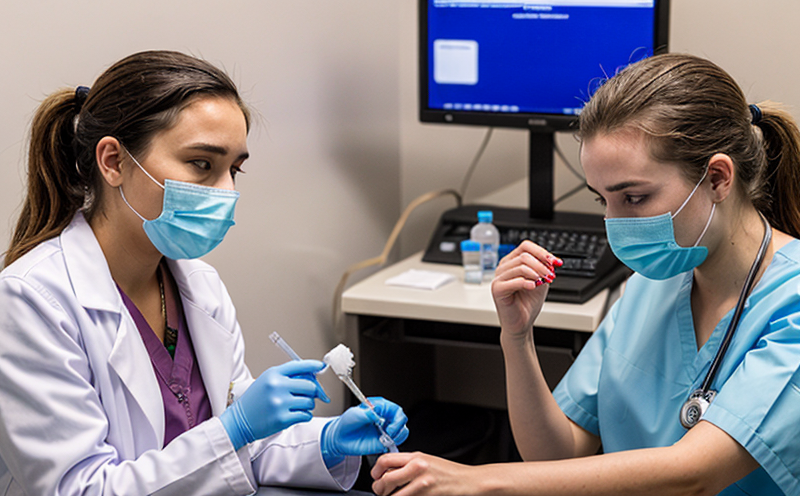CLSI M02 Disk Diffusion Susceptibility Testing
The CLSI (formerly known as NCCLS) M02 guideline provides standardized methods for performing disk diffusion susceptibility testing, which is a fundamental technique used in clinical microbiology to determine the sensitivity of bacteria or other microorganisms to antimicrobial agents. This test plays a crucial role in guiding treatment decisions and understanding the spread of drug-resistant pathogens.
This method involves placing antibiotic disks on an agar plate inoculated with the test organism. The disk releases a known concentration of the antimicrobial agent, creating a zone of inhibition around it where microbial growth is suppressed or prevented. By measuring these zones, the susceptibility profile of the tested microorganism can be determined.
The CLSI M02 protocol specifies rigorous quality controls and detailed procedural steps to ensure accurate results. These include selecting appropriate strains for standardization, maintaining accurate media recipes, and ensuring that all equipment is properly calibrated. Compliance with this guideline ensures consistent and reliable data, which is essential in clinical settings where treatment efficacy directly impacts patient outcomes.
The significance of CLSI M02 lies in its ability to provide actionable insights into the effectiveness of various antimicrobial agents against specific pathogens. This information is critical for tailoring therapeutic regimens, monitoring resistance patterns, and guiding public health policies aimed at combating drug-resistant infections.
For quality managers and compliance officers, adherence to CLSI M02 ensures that laboratories meet international standards for accuracy and reliability in susceptibility testing. R&D engineers rely on this method to develop new antimicrobial agents by validating their efficacy and identifying potential targets. For procurement professionals, understanding the nuances of CLSI M02 helps them select reliable suppliers capable of meeting stringent quality criteria.
The versatility of CLSI M02 extends beyond clinical settings; it is also used in research laboratories to study bacterial strains, monitor infection trends, and evaluate new diagnostic tools. Compliance with this guideline enhances the credibility of research findings and facilitates collaboration between academic institutions and pharmaceutical companies.
Why It Matters
Accurate susceptibility testing through CLSI M02 is vital for effective antimicrobial stewardship programs, which aim to optimize treatment outcomes while minimizing the development of resistant organisms. Misuse or overuse of antibiotics can lead to increased resistance, making it more challenging to treat infections.
- Guiding Treatment Decisions: CLSI M02 helps clinicians select appropriate antibiotic therapy based on local susceptibility patterns.
- Monitoring Resistance Patterns: Regular testing allows for the early detection of emerging resistance trends, enabling timely interventions.
- Evaluating New Agents: The results from CLSI M02 can provide critical data to support the development and approval of novel antimicrobial agents.
The importance of this testing cannot be overstated. It supports evidence-based medicine practices and contributes significantly to public health by ensuring that patients receive the most effective treatments available.
Scope and Methodology
The CLSI M02 guideline encompasses a comprehensive set of procedures designed to ensure accurate and reproducible results in disk diffusion susceptibility testing. The scope includes:
- Inoculation Procedures: Detailed instructions on preparing the agar plates, inoculating them with test organisms, and ensuring uniform distribution.
- Disk Application: Specific guidelines for placing antibiotic disks onto the inoculated plates, including the correct orientation and spacing between disks.
- Incubation Conditions: Standardized temperature and time parameters to allow the bacteria sufficient time to grow in the presence or absence of antibiotics.
- Zone Measurement: Precise methods for measuring the zones of inhibition around each disk using calipers or rulers.
The methodology also emphasizes the importance of quality control, including the use of ATCC reference strains and routine checks to verify the accuracy of media and reagents. Compliance with these stringent requirements ensures that laboratories produce reliable data that can be trusted by healthcare providers and regulatory bodies alike.
Industry Applications
| Application Area | Description |
|---|---|
| Hospital Infection Control Programs | Detecting resistant strains and monitoring trends to prevent nosocomial infections. |
| New Drug Development | Assessing the efficacy of new antibiotics against common pathogens. |
| Public Health Surveillance | Tracking antibiotic resistance patterns at a population level. |
| Research Laboratories | Evaluating diagnostic tools and methodologies for improved accuracy. |
| Pharmaceutical Regulatory Compliance | Ensuring that drug development meets international standards. |
| Patient Care Optimization | Selecting the most appropriate therapy based on local susceptibility data. |
The CLSI M02 disk diffusion susceptibility testing is widely used in these applications, contributing to better patient outcomes and more efficient healthcare practices. By adhering to this standard, laboratories can provide reliable data that supports critical decisions in clinical settings.





